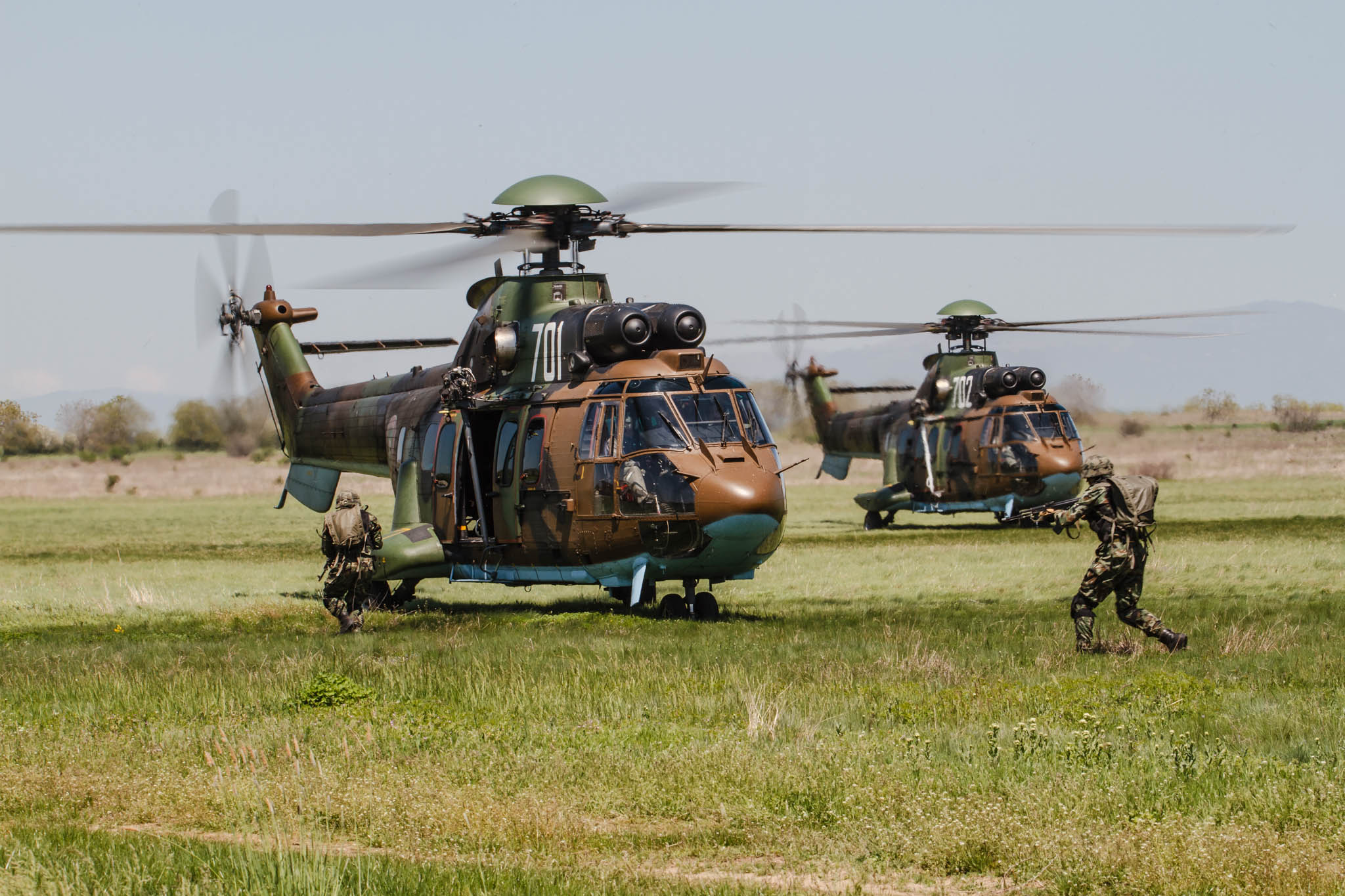Bulgaria Air Force - Bulgarski Voennovazdyshini Sili
'Bulgarian Cougars - Forge NATO Interoperability'
Plovdiv - Krumovo Air Base (24.VAB)
Plovdiv, Bulgaria
June 2009 and April 2010
|
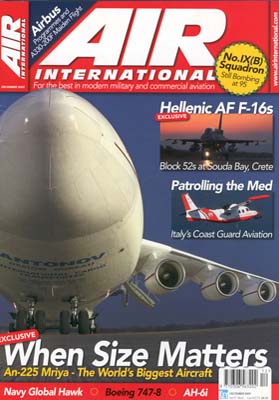
Philip Stevens for Air International reports on the 24th Helicopter Air Base of the Bulgarian Air Force at Krumovo near Plovdiv to see if they are ready to play an active part within NATO.
In March 2004, Bulgaria became a NATO member, as a former member of the Warsaw Pact, the Bulgarski Voennovazdyshini Sili - BVVS (Bulgarian Air Force - BuAF) had to adapt to new procedures and systems before they could become effective within the organisation. The restructuring of the BuAF to achieve NATO interoperability for its air force gathered pace in January 2005 when the Bulgarian Defence Minister signed a 360 million euro contract with Eurocopter for 12 AS.532UL/AL Cougar and six AS.565MB Panther helicopters. In 2005 it was also announced that the Bulgarian Ministry of Defence had signed a 57 million euro contract with Israeli firm Elbit Systems, who in conjunction with Lockheed Martin were to repair and upgrade 12 Mil Mi-24 ‘Hind’ and six Mil Mi-17 ‘Hip-H’ helicopters. The upgrades would bring the helicopters up to NATO standards and ensure interoperability. However in March 2007, with some MI-24’s already stripped down, the contract was cancelled apparently by mutual consent. It is unclear whether or not the lack of funds available or Russian objections to Elbit undertaking the work, were the underlying factors in this decision. |
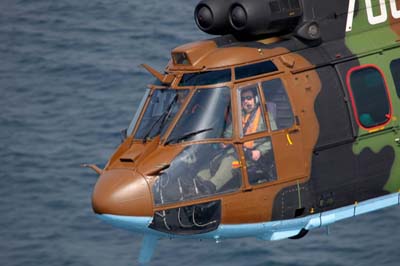 |
General S Petrov base commander of Krumovo at the controls of a AS.532UL over the Black Sea. |
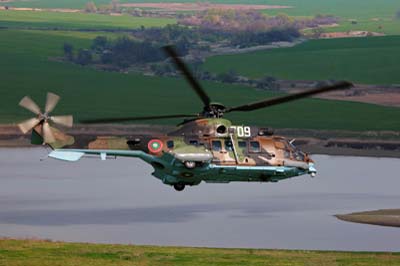 |
‘709’ was the first of four AS.532AL Cougars to be delivered for the CSAR role. During the exercises the AS.532 pilot will circle over two or three areas away from the ‘downed’ pilot to lure opposing forces away, before closing in for a rescue. |
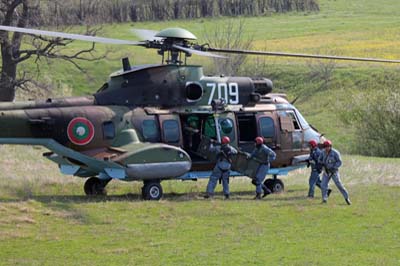 |
Members of the Krumovo based Search and Rescue team assume the full role of a CSAR operation during an off-base training exercise, in preparation for the planned Forceval later in the year. |
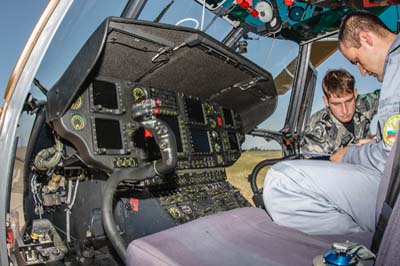 |
A 2/24 Vertoletna Avio Eskadrila (2/24VAE) pilot signs off, after a training flight. The AS.532 Cougar is the only helicopter in the BuAF fleet with instruments compatible for use with night-vision goggles (NVG). Krumovo’s pilots fly in total around 4,000 hours per year. |
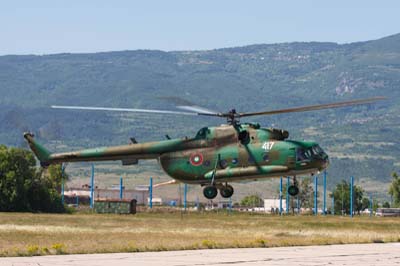 |
Mi-17 ‘417’ returning to Krumovo in June 2009, at the end of the first phase of the one day training exercise, in preparation for the Forceval planned for later in the year. In the background are the first signs of the new hangar being built for the twelve AS.532, constructed as part of the contract with Eurocopter. The Mi-17 was used for troop transport and fast-drop on the landing zone, before being used later for troop exfiltration during a Medevac exercise. |
The Journey Begins – A Man on a Mission
Brig General Stefan Petrov is a man on a mission during the most testing times the BuAF have faced since the Treaty of Neuilly-sur-Seine was signed in 1919 and Bulgaria was banned from operating military aircraft for 20 years. Gen Petrov, Commander of the 24th Helicopter Air Base (24 Vertoletna Aviocionna Basa -24.VAB) at Plovdiv-Krumovo, has the task of achieving NATO certification for the AS.532UL Cougar for Medical Evacuation (Medevac) duties.
Gen Petrov an experienced fighter pilot was trained to fight on the Mikoyan-Gurevich MiG-17 and MiG-21 before he progressed to helicopters. Speaking fondly of his time on the MiG-17 he jokingly remarked; “If the MiG-17 had modern avionics it could still do a job today. It was a very nice aircraft to fly”.
To gain as much knowledge as possible and to guide his team to NATO Medevac certification, he travelled to Canada. At CFB Trenton (424 Transport and Rescue Squadron) and CFB Bordon (400 Tactical Helicopter Squadron) he was able to learn how they perform Medevac operations and was very impressed with their operations during his three month stay.
The General also gained valuable knowledge during a visit to Kosovo recently for a Medevac conference hosted by the French military. The invitation was arranged through the French Ministry of Defence in Sofia, who have also provided them with an advisor since the AS.532 contract was signed.
The Cougar Contract
The first of 12 AS.532UL/AL for the BuAF (serials 701 to 712) was formally handed over to Gen Petrov at Krumovo on August 28, 2006. The AS.532 joined Mi-17’s flown 2/24 Vertoletna Avio Eskadrila - 2/24VAE (2nd Helicopter Squadron). The first eight aircraft are being used as utility transports and for Medevac duties; they are easily converted to suit each role. The AS.532 with a crew of two can carry 29 troops or six injured people on stretchers with ten other medics or passengers.
The final four AS.532AL, with the last one delivered in July 2009, have been adapted for CSAR operations. In addition to Forward Looking Infrared (FLIR) camera they have a suite of self-defensive equipment such as; Kevlar shields to protect the pilots, Radar Warning Receivers (RWR) and Chaff and Flares, which were delivered with the latest helicopter. Armament for the AS.532AL (AK 7.62mm machine guns) will be fitted by the end of 2009. Clearly everyone involved with the AS.532 since they first arrived is very impressed with its performance and reliability. Gen Petrov commented, “The AS.532 has excellent avionics and is very reliable, it is perfect for us to perform our missions”.
All AS.532 pilots initially undergo a month of training at Eurocopter’s Marignane facility in France to obtain type qualification. A French instructor is stationed at Krumovo to assist with flight training. By September 2009 the Squadron planned to have a full complement of pilots and co-pilots capable of all-weather, day-night flying that includes over the sea and high-altitude mountain landing zone operations. All pilots must fly at least 180 hours per year to maintain NATO standards
As part of the Eurocopter contract, an ‘offset program’ included the provision of a new and very modern 5,000 Square meter (53,800 Sq Feet) hangar with humidity controls and a firefighting system to contain and protect the new helicopters. By June 2009, construction was well underway and completion was expected by September. Eurocopter specialists have trained Bulgarian engineers at Krumovo to undertake 50 and 100 hour inspections on the AS.532. The 500 hour inspections will continue to be done at Terem’s facility at the nearby Graf Ignatievo air base. The 2/24 VAE is currently housed in a building built by the Germans during World War Two, as part of the ‘offset program’, a new building for the Squadron is due to be completed by the autumn of 2009.
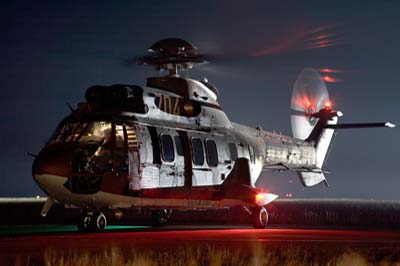 |
AS.532 ‘704’ is about to depart on a night flying training exercise using NVG’s. |
Learning to Fly in the Dark
Critical to Medevac operations is the ability to fly at night. Being qualified to fly using night-vision goggles (NVG) is therefore a necessity. The Mi-17 and Mi-24 with their red light instrumentation are not NVG compatible. Consequently, it was not possible until the arrival of the first AS.532 to train to fly with NVG’s. Gen Petrov personally looked in vain for NVG specialists suitable to develop a training course for his squadron’s aircrew. The only option was to construct their own training course for night-flying procedures. The first of two night-flying manuals were produced with the help of a Research Institute from Sofia, who sent a specialist to Krumovo to help develop a theoretical program. The second manual for the flight program produced by Gen Petrov and his staff, utilised parts of French and English manuals that were available.
Eventually they were ready to start the NVG flying program. On a night with a full moon in June 2008, with Gen Petrov at the controls, he made the first of a series of flights in the AS.532. Initially these flights were made within the confines of Krumovo air force base. Step by step, hovering progressed to low level flights with landings made around the airfield and later to sorties which involved following roads in the local area. The judging of distance and the NVG’s limited angle of view were found to be the first challenges for pilots to overcome, flying through the nearby mountain ranges were deemed the most demanding. A pilot typically requires 15 to 20 hours of NVG night flying to qualify. Gen Petrov was the first pilot to be certified to fly with NVG’s by a Council from Air Force headquarters at Sofia. It is expected that all 2/24 VAE AS.532 pilots following in the General’s footsteps will be similarly qualified for NVG use by September 2009. Some pilots with 50 hours experience have now become qualified NVG instructors.
Looking to a Bright New Future
Krumovo is ideally situated in the centre of Bulgaria close to the second city of Plovdiv and has a history of helicopter operations. In 1961, the 44th Aviation Helicopter Regiment operated from an airfield in Plovdiv town which has since been built on. In 1980, they moved to Krumovo and were subsequently renumbered the 24th Aviation Helicopter Regiment. Krumovo airfield dates back to the 1930’s and still has a number of German built buildings from World War Two.
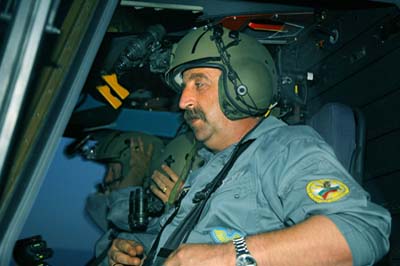 |
General S Petrov (left seat) and Colonel E Belkinov prepare for one of the first night flying training exercises using NVG’s within Krumovo air base. The very experienced Petrov and Belkinov are the only two pilots in the BuAF qualified to fly the, AS.532, Mi-24, B.206 and Mi-17 helicopters. |
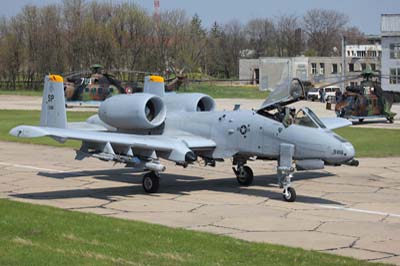 |
In April 2009 the 81st Fighter Squadron (FS) of the 52nd Fighter Wing (FW) based at Spangdahlem were deployed to Bezmer air base for exercise ‘Reunion April’. Working with BuAF AS.532’s the A-10C’s they were used for Close Air Support (CAS) flying over the Novo Selo training range, which is 28 miles (45 Km) from Bezmer. |
Bulgaria is positioned right on the eastern side of NATO and shares borders with, Romania, Greece, Serbia, Macedonia and Turkey. It features two vast mountain ranges with two long valleys and a Black Sea coastline. At the end of the ‘Cold War’ Bulgaria reconsidered its position within Europe. In 1990, when NATO, with nearly 30 former Warsaw Pact nations, signed a Joint Declaration which stated that they no longer regarded each other as adversaries. The resulting North Atlantic Cooperation Council (NACC) held its first meeting in 1991. Further progress was made when NATO invited the NACC and the Organisation for Security and Cooperation in Europe (OSCE) countries to join a ‘Partnership for Peace’ (PfP). The PfP program was designed to bolster security through co-operative effort. The accession of Bulgaria to the European Union took place on January 1, 2007.
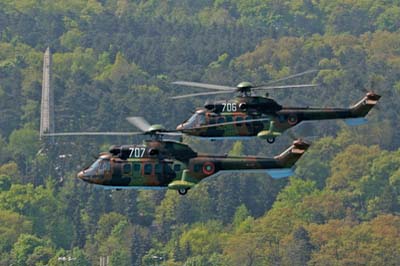 |
Two AS.532UL Cougars over Sofia enroute to a CSAR training exercise. The obelisk is a symbol of Communism in a park. |
NATO Common Procedures
Bulgaria recognised that they need to take part in military exercises with their new partners. Before joining NATO, they took an active role in the PfP program of annual exercises named ‘Cooperative Key’, which they hosted in 2001 and 2003 and again 2005, after they had joined NATO.
Every two years starting from 2007, Romania and Serbia join Bulgarian forces in joint Medevac, SAR and tactical transport exercises known as ‘Danube Guard’ centred along the Danube River.
In March 2009, two AS.532 participated in the ‘Thracian Spring’ exercise centred around the Forward Operational Base (FOB) at Bezmer. They were working with USAFE’s 37th Airlift Squadron, 86th Airlift Wing with its brand Lockheed C-130E and brand new C-130J Hercules which are based at Ramstein, Germany. Valuable experience was gained in the Medevac, CSAR, reconnaissance and transport operations.
In April 2009, exercise ‘Reunion April’ further enabled 2/24 VAE to work with the USAFE. This time two AS.532 and Bezmer’s Sukhoi Su-25K ‘Frogfoot’ operated with six Fairchild-Republic A-10C Thunderbolt II’s from the 81st Fighter Squadron (FS) of the 52nd Fighter Wing (FW) based at Spangdahlem, Germany, in the Combat Search and Rescue (CSAR) and Close Air Support (CAS) role. During this exercise both, A-10C and Su-25K pilots were taken to the Novo Selo range to simulate downed pilots requiring rescue from hostile territory. The A-10’s provided CAS as the BuAF AS.532 came in and collect the pilots under the guidance of a Forward Air Controller (FAC). Major Filip Angelov, 2/24 VAE Commander clearly welcomed the opportunity to work with the Americans. “These kind of exercises are very useful, we can compare our methods. As a member of NATO we need to have common procedures. The 81st FS have recently returned from operations in Afghanistan and had many experiences to share”.
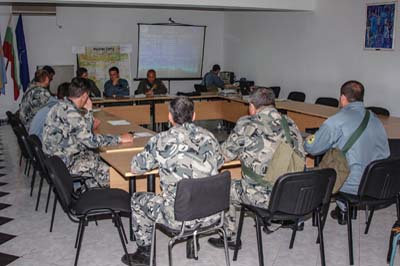 |
Maj Angelov is in control of the Squadron Operations Centre (SQOC) at Krumovo during the Medevac training exercise which was centred on and around Stara Zagora in June. His immediate team consisted of Operations and Duty Officers there were; Force Protection (ground and deployed), Intelligence, Security, Nuclear Biological Chemical (NBC), Meteorological and Medical Officers. They were backed up with Logistic, Human Resources (HR), Computer Information Systems (CIS) and two Communications Officers. |
Preparing for a NATO Forces Evaluation (Forceval)
By far the most important exercise this year for Gen Petrov and the 2/24VAE is a Forceval which is to be held in September this year. Since joining NATO in 2004, it has been important for the Bulgarian government and military alike to be able to declare a capability to NATO. In September Forceval evaluators from Air Component Command (CC-Air) at Izmir, Turkey will visit Krumovo to evaluate and hopefully certify the squadron to perform Medevac operations on a 30 day readiness. “Over two weeks we have to show the evaluators how we can prepare for deployment and actually deploy abroad”, reported Maj Angelov. He was looking forward to obtaining certification, going on to say; “Operations in Iraq and Afghanistan have proved the value of helicopters over a range of missions”. His expectation following certification was to be deployed to Kosovo or Afghanistan.
“NATO certification and Forceval is not just for pilots”, reported Colonel Zlatko Zlatev, Deputy Base Commander of Krumovo with 2,350 hours in his log book. “It involves maintenance, logistics and force protection”. Medical training is also a key factor for an effective force. The Medical Academy (MMA) in Sofia which was formed in 1989, at the Ministry of Defence has so far played an important part in this process.
Month’s of hard work has gone into preparing the 2/24 VAE for the Forceval. Now in the final stages towards gaining NATO Medevac certification, Gen Petrov has planned a series of four tactical exercises, the first was in June. Maj Angelov was in direct charge of the Squadron Operations Centre (SQOC) at Krumovo. The Medevac training exercise centred on and around the former 23rd Attack Helicopter Air Force Base of Stara Zagora some 20 miles (32 km) from Krumovo. At 07:30 key personnel attended the daily mass briefing to report on their readiness to perform the assigned mission which was followed by pre-flight briefings with the mission leaders.
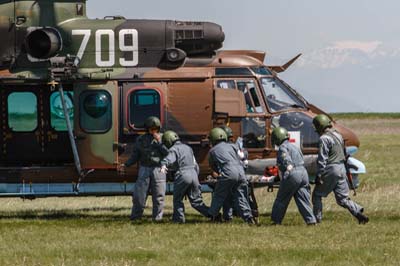 |
Medevac team collecting the wounded during an exercise at Chernogorovo. |
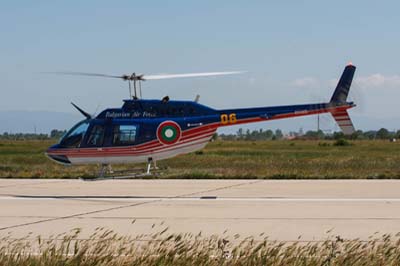 |
Bell B.206B-3 ‘06’ is one of six delivered in 1999 to the Otdelna Uchebno Aviozveno (OUAZ) which is an Independent Training Flight based at Krumovo. Gen Petrov is at the controls practising auto-rotating landings. Following an engine failure, a helicopter may be able to slow its descent before landing in a controlled manner. Bell 206 pilots are expected to fly between 80 and 120 hours per year. Students from the flying training school will fly 60 hours per year. |
The SQOC consisted of a large team of specialists necessary to provide the SQOC Commander with the backup needed. Along with the Operations and Duty Officers there were; Force Protection (ground and deployed), Intelligence, Security, Nuclear Biological Chemical (NBC), Meteorological and Medical Officers. The team was backed up with Logistic, Human Resources (HR), Computer Information Systems (CIS) and two Communications Officers.
Missions
Four main tasks were to be performed by friendly ‘Aland’ forces in the day, starting with an air-reconnaissance by a Krumovo based Bell 206B-3 helicopter. A tactical transport task was flown by a Mil Mi-17 complete with logistical supplies and a complement of troops, which were to be fast-dropped on to the landing zone (LZ). In support of this operation were two AS.532AL configured for the Combat Search and Rescue Role (CSAR). A further two AS.532UL were configured for the Medevac role to complete the airborne mission package.
The first phase of the exercise for ‘Aland’ forces was to create a buffer zone. By 12:30 the air-reconnaissance, fast drop and CSAR was complete, the LZ was secure and downed pilot recovered. A small group of opposing forces from hostile ‘Beland’, including ‘snipers’ were found in the operational area, according to a radio communication received at SQOC. The second phase utilised a similar package of helicopters necessary to perform a further air-reconnaissance by a B.206, Medevac with two AS.532AL and a Mi-17 for troop exfiltration.
At end of the exercise Maj Angelov was very happy, if not relieved that all had gone well. “We had goals to achieve, requiring good interaction between operations, logistical and force protection. Good communication was essential to perform our mission”. A NATO requirement is that all communication is in English which puts an added strain on procedures. The only reported problems were an electrical fault in one of the AS.532 which was corrected in-flight and a ‘Channel 16’ fault which was solved by CIS Officers at SQOC.
“Everywhere, Anytime”
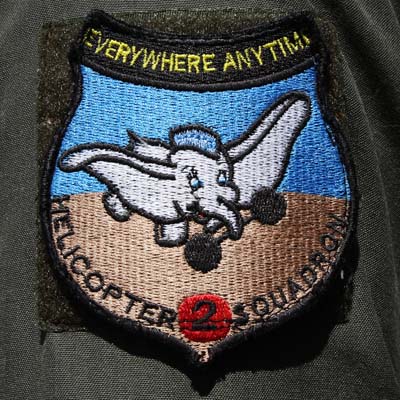 From Gen Petrov downwards, it was obvious that they were all working hard, not just to achieve NATO certification at the forth-coming Taceval, but to play active role in NATO operations abroad, whether it would be in Kosovo or Afghanistan, as presumed by Gen Petrov. To keep in shape, the BuAF and Gen Petrov in particular are firm believers in physical fitness. His staff are required to do regular 1,000m runs and timed shuttle runs. Funds for new sports halls have been approved at Bulgaria’s active air bases.
From Gen Petrov downwards, it was obvious that they were all working hard, not just to achieve NATO certification at the forth-coming Taceval, but to play active role in NATO operations abroad, whether it would be in Kosovo or Afghanistan, as presumed by Gen Petrov. To keep in shape, the BuAF and Gen Petrov in particular are firm believers in physical fitness. His staff are required to do regular 1,000m runs and timed shuttle runs. Funds for new sports halls have been approved at Bulgaria’s active air bases.
They are very keen to play their within NATO and to live up to the 2/24 VAE motto of “Everywhere, Anytime”, Maj Angelov knows only too well what a difference they can make in times of crisis. He was involved in Bulgaria’s most welcomed humanitarian assistance provided to Turkey at the time of the 1999 earthquake west of Ankara, when initially 17,000 people were killed. “For me it was the most rewarding operation, we deployed two Mi-17 for rescue and logistical support and helped to save countless lives”.
In November Gen Petrov was confident that NATO certification would be awarded. The determining Forceval exercise, named ‘Turning Point 09’ which ran from September 19 to 22, had gone according to expectations. The NATO inspectors from Izmir had given him a positive assessment. For Gen Petrov NATO certification is the reward he deserves for the devoted effort he has put in to the task.
I would like to thank Gen Petrov and his staff at Krumovo who all made me feel very welcome and gave their time freely for interviews to enable me to produce this article for Air International, during my three days on base.
Please note: Some additional images were provided by my good friend Ognyan Stefanov |

